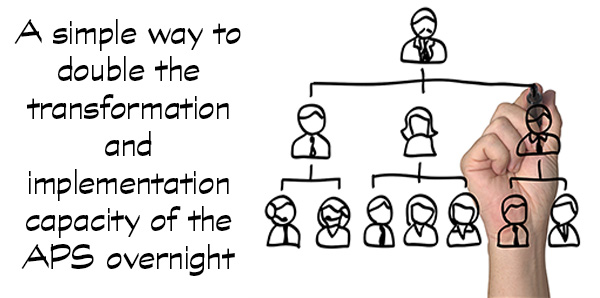A recent survey of over 800 state and federal employees recently conducted by Professor Peter Shergold and highlighted by The Mandarin suggested that nearly three-quarters of public servants believe the public service is too hierarchical.
I agree.
There is a very simple way to translate this disquiet into a dramatic increase in management capacity – overnight.
Management of Transformation and Policy Implementation
The vast majority of large public sector organisations are trying to implement major changes. Some are about policy delivery, some are behind the scenes, many of them are digitally enabled.
Pretty much every single department and agency uses programme and project management disciplines to manage transformation and policy implementation. So far so good.
However, in my experience the public sector is in most cases clumsy in its implementation of these disciplines. Specifically, global experience and best practice tells us that programmes and projects are best established as temporary organizations. Yet the APS often dilutes, or even ignores this, and attempts to manage them using permanent hierarchy. Programme and project decision-making is mechanistically driven through each level of the hierarchy. This creates unnecessary frustration, confusion, delay and bureaucracy.
What is required?
Based on global experience and best practice, you only need three layers to manage change:
- The first layer to set direction and make overall decisions;
- The second layer to manage the programme or project;
- The third layer to manage the work of the delivery teams.
Those layers are combined into a coherent, temporary role-base structure (programme or project), that reports to a designated point.
How would this work in the APS?
Currently programme and projects are managed at all layers, typically five or six of them: APS6, EL1, EL2, SES1, SES2 and SES3.
If this mindset is replaced, you skip levels and simply have one layer each for direction, programme/project management and delivery management: by doing so you have just doubled your capacity to manage transformation and policy implementation. You can have different levels doing different things according to the nature of the initiative (e.g. type, scale, complexity, risk etc), as long as you skip levels.
I know some programme and project management purists may wish to challenge me on levels, sub-structures etc, but the basic mathematics is plain: if half the workforce manages one set of initiatives, and half the workforce manages the other, by skipping alternate levels you have doubled your management capacity.
A bit too radical? Well how about we at least skip some levels, instead of taking global best practice and forcing it through every level of the hierarchy?
Do you agree?
Please comment on the blog itself or via LinkedIn.
Feel free to call me personally on 0407 404 688 or email me at john.howarth@tannerjames.com.au.






Leave A Comment